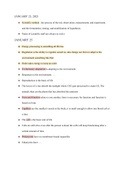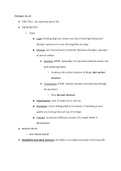Gisselgarcia
On this page, you find all documents, package deals, and flashcards offered by seller gisselgarcia.
- 3
- 0
- 0
Community
- Followers
- Following
3 items

Chemistry of life and membrane structure and function
Concepts/Topics 1. Scientific method and hypothesis formation. 2. Seven different properties of life. 3. Themes that unite life. a. How organisms interact with their environment and role of energy. b. How form relates to function. c. The cell as the basic unit of life. d. DNA, inheritance and gene expression. e. Classifying molecular biology via “-omics”. f. Mechanisms of regulating systems. g. Classification of life. h. Evolution as the central theme to life. 4. Characteristics ...
- Class notes
- • 27 pages •
Concepts/Topics 1. Scientific method and hypothesis formation. 2. Seven different properties of life. 3. Themes that unite life. a. How organisms interact with their environment and role of energy. b. How form relates to function. c. The cell as the basic unit of life. d. DNA, inheritance and gene expression. e. Classifying molecular biology via “-omics”. f. Mechanisms of regulating systems. g. Classification of life. h. Evolution as the central theme to life. 4. Characteristics ...

Cells and photosynthesis
Concepts/Topics 1. Know the characteristics of microscopy and cell fractionation and how they can be used to study cells. 2. Characteristics of prokaryotic and eukaryotic cells and what makes animal and plant cells different. 3. Characteristics of the nucleus. 4. Ribosome characteristics. 5. Endomembrane system – know the characteristics and functions of each component and how the system is specifically organized for shuttling molecules within the cell. 6. Mitochondria and chloroplasts ...
- Class notes
- • 25 pages •
Concepts/Topics 1. Know the characteristics of microscopy and cell fractionation and how they can be used to study cells. 2. Characteristics of prokaryotic and eukaryotic cells and what makes animal and plant cells different. 3. Characteristics of the nucleus. 4. Ribosome characteristics. 5. Endomembrane system – know the characteristics and functions of each component and how the system is specifically organized for shuttling molecules within the cell. 6. Mitochondria and chloroplasts ...

Cell communicatio, protein, gene expression, lac operon, and cell cycle miosis/mitosis
Concepts/Topics 1. Why is cell communication important? 2. Know the different ways cells communicate with each other. 3. Understand cell signaling beginning with the types of receptors, receptor-ligand interaction (reception), and ending with the different ways cells can respond. 4. Understand how gene expression relates to genotype and phenotype. 5. General differences between bacterial and eukaryotic transcription and translation. 6. Messenger RNA synthesis and processing. 7. Mechanism...
- Class notes
- • 32 pages •
Concepts/Topics 1. Why is cell communication important? 2. Know the different ways cells communicate with each other. 3. Understand cell signaling beginning with the types of receptors, receptor-ligand interaction (reception), and ending with the different ways cells can respond. 4. Understand how gene expression relates to genotype and phenotype. 5. General differences between bacterial and eukaryotic transcription and translation. 6. Messenger RNA synthesis and processing. 7. Mechanism...
